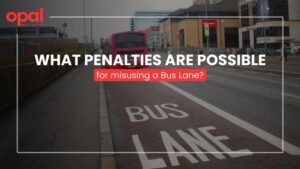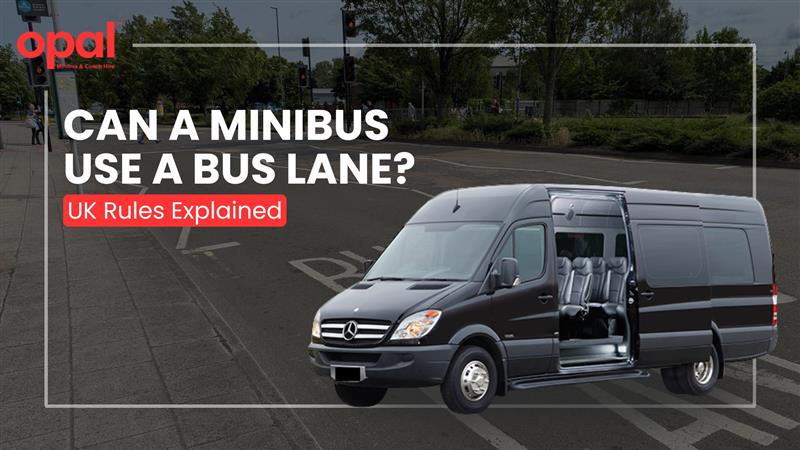Generally, yes, a minibus can use a bus lane, but not always, just in certain circumstances. It typically depends on the type of lane, signage, vehicle classification, and local council regulations. Most bus lanes allow ten-seater and larger vehicles to use them, but some may be reserved for local bus services only by indicating them with ‘local’ signs. Moreover, this scenario may also lead to uncertainty, drivers’ confusion, and potential misuse.
In order to cater to any unfavorable situation to may come, at OPALTM, we keenly inform minibus drivers about the rules surrounding bus lanes and how they might apply to them.
What is a Bus Lane?
A bus lane is generally a designated lane on a road, reserved for buses and sometimes taxis, cycles, or other authorized vehicles. This helps in travelling with fewer delays, reducing bus congestion, and improving traffic flow, making it reliable and efficient.
The Highway Code rule 141 specifies the bus lane nationwide. According to this rule, there are some road markings and signs to show bus lanes that indicate which (if any) other vehicles are permitted to use them. Otherwise, no one should drive in a bus lane during its operation period. Where a bus lane is not prohibited from use, you may stop, load or unload there without any hassle.
Bus lanes may have specific operational times or be in effect 24/7. Violating bus lane restrictions can result in fines for unauthorized vehicles.
What types of Bus Lanes are in the UK?
Generally, bus lanes are categorized into two major forms: full-day bus lanes and time-restricted bus lanes. Besides, some other types of lanes, based on the location and vehicle types, also allow vehicles to move.
Let’s describe them briefly!
- Full-Day Bus Lanes remain operational 24/7, unless otherwise indicated by signage.
- Time-Restricted Queues operate only during designated times, often during peak hours, improving bus service reliability and efficiency.
- Bus-Only Streets are mostly reserved exclusively for buses and other authorized vehicles like taxis.
- Bus Lanes with Exceptions may be open to certain other vehicle types like taxis, mopeds, motorcycles, or bicycles, and indicated by signs or markings.
- Bus Gates are road’s short sections where buses have priority, often at junctions with traffic signals.
- Busways are actually roadways dedicated to only buses, but sometimes with guided bus systems.
- Kerbside Bus Lanes are located next to the curb, often with red surfacing.
- Centre of Carriageway Roadways are usually located in the center of the road, often with red surfacing.
But make sure you follow local regulations and check signage because different local authorities have different rules and allowed vehicle types. And many bus lanes are monitored by cameras to enforce regulations.
What defines a Minibus?
A minibus is legally a motor vehicle, larger than a car and smaller than a coach, typically comes with between 9 and 16 passenger seats, including the driver’s seat, catering to small groups travelling.
Minibuses can be categorized based on their usage, primarily into private hire for pre-booked transportation, public service vehicles (PSVs) for public transport with fares, and school minibuses to transport students.
In the UK, you must have a D1 category on your driving license while driving a minibus. It permits the holder to drive max 16-seater minibuses with a maximum range of 8 meters and towing a trailer up to 750kg or a full D (PVC) entitlement, especially if you hire or reward passengers.
There are certain scenarios where exemptions to standard licensing rules might apply, e.g., driving for a voluntary organisation under specific conditions.
Can a Minibus Use a Bus Lane in the UK?
In the UK, if a bus lane is not specifically designated as local or bus-only services, then minibuses with 10 or more seats, including the driver’s seat, are generally allowed to use bus lanes. But in this scenario, the specific rules can vary by location, so it’s crucial to pay attention to the signage at each bus lane.
Let’s have a detailed breakdown on: Can minibuses use bus lanes in the UK?
A General Thumb Rule
In order to access the bus lane, be assured that the vehicle must have a minimum of 10 or more seats (including the driver), as it is often considered a bus. This is important to note because if lanes are restricted to only buses or specify ‘local’, then a minibus should meet their criteria to be in that queue.
Laser-focused on Signage
It’s the most important factor. Always keep your eyes on the bus lane signage for any specific restrictions or permitted vehicles and the times of operations. If it says “local” or “Bus Only,” it’s reserved for local bus services only, regardless of the number of seats. It means a minibus can’t move on that lane.
Other Vehicles Permit
Depending on the local rules and signage, other vehicles like taxis (where permitted), motorcycles, mopeds, and bicycles may also be allowed in some bus lanes in addition to buses.
Licensing
Before driving the minibus, make sure you’re properly licensed and are aware of any relevant driver’s hours rules, particularly if carrying passengers for hire or reward, because bus lanes can often be used by all vehicles outside of their operating hours, which are indicated on the signs.
Local Regulations
As bus lane rules can vary city or area-wise, it’s always best to understand the specific rules for each location you’re driving in.
24/7 Operations
If there is no any sign indicating any specific time of operations of a bus queue, then it’s in effect 24 hours a day and 7 days a week.
Fines & Penalties
Any act done while driving which is against UK laws will lead to heavy fines. Moreover, using a bus lane when you’re not permitted or any misuse can also result in a Penalty Charge Notice (PCN).
What Penalties are possible for misusing a Bus Lane?

In the UK, misusing a bus lane can lead to a Penalty Charge Notice (PCN), a civil penalty issued by local authorities. The fines for bus lane contraventions generally range from £60 to £180. But it’s not the ultimate amount. Outside of London, a £60-£70 fine is issued, whereas in Greater London, fines are higher, usually £130-£180.
If the PCN is paid within a specified period (around 14 to 21 days), many authorities reduce their fines by 50%, like £30-£35 or £65-£90. If the PCN is not paid within the initial period, the fine may increase up to 50%. For example, a £70 fine may increase up to £105 or even higher.
Bus lane enforcement aims to ensure that only authorized vehicles use designated bus lanes. This primarily relies on CCTV cameras to record vehicles illegally driving or stopping in these queues. The evidence (either video or still images) is then used to issue a PCN to the registered keeper of the vehicle. Besides, bus lane attendants/traffic wardens may also be present on the ground to issue PCNs directly for bus lane infringements.
What are the Best Practices for Minibus and Coach Drivers to Use the Bus Lane?
There are some best practices given for the safe and legal use of bus lanes. Just follow them! 👇
- Always check for operational signs and markings before entering! These are usually blue-coloured signs and are located before the bus lane and repeated along its length.
- Be aware of the specific vehicle types permitted! Confirm whether your vehicle is authorized or not for that lane, as per the signage, by consulting the local council or contacting your hire company.
- If in doubt or lane markings are unclear, especially during peak hours, it’s better to avoid ambiguous zones.
- Make sure you signal your clear intentions and allow ample space for other vehicles while passing or merging with a bus lane.
- Maintain a safe distance while following buses, especially when they’re approaching bus stops or turning. Besides, signal your clear intentions and allow ample space for other vehicles while passing or merging with a bus lane.
Let’s Wrap Up Quickly!
If you’re a minibus driver and worried about ‘Can a minibus use a bus lane or not?’, so keep in mind that yes, you can use it, but with a few restrictions. Make sure your vehicle has 10-16 seats, check out the sign of ‘bus lane’ and if there is a ‘local’ mention, avoid moving there.
As you’re driving your minibus in the UK, so consider their traffic laws and penalties. Any misuse of a bus lane will lead to fines or PCNs. Check out the local policies and regulations before entering the bus lanes.
Last but not least, if you’re planning a group journey, OPAL’s licensed minibuses and expert drivers ensure your trip is both legal and stress-free. Interested? Get a free quote today!
Frequently Asked Questions
Can I drive a minibus in a bus lane?
Yes! You can drive a minibus in a bus lane, depending on the specific bus lane and its signage. Well, minibuses with 10+ seats are often permitted, except there is a ‘local’ sign indicated on the lane.
What vehicles can go in a bus lane?
Vehicles, including buses, cycles, mopeds, motorcycles, and taxis, are generally allowed to use bus lanes. However, the specific rules may vary based on the location and time of day, so it’s crucial to check the signs indicating when the bus lane is in operation and which vehicles get a green signal to go.
Can I drive in a bus lane after 7 pm?
Absolutely! In most cases, you can drive in a bus lane after 7 pm. But as the operational hours vary, there are limited peak traffic times. So if the bus lane has signs indicating specific operating hours and 7 pm falls outside of those hours, then it’s generally permissible to use it and vice versa.
What happens if I drive a minibus in a bus lane mistakenly?
Simply, it may result in a Penalty Charge Notice (PCN) from the local authority. The bus lane rules enforcement is often done via cameras, and rule-violating drivers may be charged a specific fine. However, some councils may also offer first-time warnings before issuing a fine.
How much is a bus lane fine in London?
In London, the standard fine for driving in a bus lane is £160. And this applies to all bus lanes and moving traffic contraventions. However, local authorities usually offer a 50% discount on the fine if it’s paid within 14 days.
